

Outreach and #scicomm @CarnegieMNH with some PA beer at the Nature Crawl with @abby_june24. Mounting pressed plants for the @OakGroveElem Herbarium @EmoryHerbarium @ogestem @DCSDSTEM @DeKalbSchools @CWATSONHARRIS. I shall be steaming (well, dieseling) through Devon on the train in the next few days, a county that was so inextricably linked with ferns that as late as 1927 James Pascall, chocolate and confectionery manufacturers, issued a set of thirty trade cards fe. Check out this book! From MBG. The walls of the stairs off the main hall at @WollatonHall are adorned with the pressed #plants, many of which were collected by Nottingham born botanist Harry Fisher - nice. Good display of #botany #MuseumNerds @JackDAshby.
Cambridge Festival Event. University Herbarium Hack: 'How to' Workshop. Join the Curator of the University Herbarium, Dr Lauren Gardiner, to learn how you can contribute to this exciting and new-for-Cambridge citizen science project.
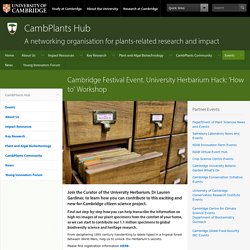
Find out step-by-step how you can help transcribe the information on high res images of our plant specimens from the comfort of your home, so we can start to contribute our 1.1 million specimens to global biodiversity science and heritage research. From deciphering 18th century handwriting to labels typed in a tropical forest between World Wars, help us to unlock the Herbarium’s secrets. Please find registration information HERE. This event is part of the 2021 Cambridge Festival.
Outreach. K-12. College. The specimens on display at the @MSUBroad art museum for the "Seeds of Resistance" exhibition are back home in the @MSU_Herbarium. It was an honor for our #herbarium #specimens to be exhibited alongside such wonderful works by many talented artists. Thank. The exhibit is called Seeds of Resistance and includes art featuring #seeds, #herbaria, and more. There through July. Such great visibility for herbarium science! Happening now at @MSUBroad, an exhibit featuring an interview with @prather_alan, #Herbarium director, and featuring several specimens from our collection! Do not miss!
Also a video about the Beal Seed Experiment featuring our colleagues @weber_mg and @DavidBLowry as well as Frank Telewski. Nice to see MSU Plant Biology so we'll represented in an art gallery! @MSU_NatSci @msuresearch. The End of Botany: Trends in Plant Science. Goldenrods in Bloom: A Quick ID Guide. Often under-appreciated by beachgoers, we're kicking off our beach-themed thread with some stunning seaweeds collected in Pembrokeshire and Devon – see this display in Hintze Hall! #MuseumStaycation. The Global Garden project: Imagining plant science - Lee - 2020. The Global Garden project offers a new perspective on public engagement in plant science.

It translates over 10 years experience of work with children, conducted by the Science, Art and Writing Trust (www.sawtrust.org) (Osbourn, 2009), into workshops for groups of adults who have a professional or personal interest in plant science. It brings gardeners, biotechnology regulators, researchers, and artists together to re‐imagine plant science and its ethical and social implications using art/science discourses. The core purpose of the Global Garden project is to use poetry and visual art as means for adult participants to develop their understanding of plant science, and to foster their imagination about this topic and the host of social and ethical issues its application implies through creative means. Fantastic afternoon spent at the @bodleianlibs new #RootstoSeeds exhibition (in the Weston’s ST Lee Gallery until Oct 24). Plenty of hat-tips to @LinneanSociety luminaries, and a huge selection of rare books on display (most from the Sherardian collection.
Flowers are really difficult to display in museums, and so are often completely left out. But these beautiful botanical models are a brilliant way of ensuring they are included. #PlantBlindness #MuseumBias #MuseumNerdsAbroad. Biodiversityliteracy. Module Development and Implementation Experience: This is for individuals wishing to commit to working in a community of practice, alongside researchers and scientists from the museum community to modify, adapt, and implement a module in the virtual classroom.
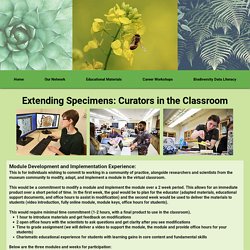
This would be a commitment to modify a module and implement the module over a 2 week period. This allows for an immediate product over a short period of time. In the first week, the goal would be to plan for the educator (adapted materials, educational support documents, and office hours to assist in modification) and the second week would be used to deliver the materials to students (video introduction, fully online module, module keys, office hours for students).
This would require minimal time commitment (1-2 hours, with a final product to use in the classroom). Below are the three modules and weeks for participation: COVID-19 Houseplants - Our Changing Relationship with Plants. “Since when did people start naming plants?”

My mother asked me. We were at the dining room table, scrolling through pictures of plants on my iPhone. The photos—close-ups of all kinds of houseplants—had been posted on Instagram by “proud plant parents.” One plant, for example, was named Lazarus because he (the poster’s choice of pronoun) “rose from the dead,” like the Biblical figure. A pair of cacti, potted together, were named Sarawat and Tine after the lead characters of a Thai TV series.
My mother’s puzzlement is understandable. A year ago, I would have felt a similar puzzlement. Recently, I’ve started researching whether there has been a shift since the start of the pandemic in how people in the Philippines are engaging with indoor plants. The parent-of-a-toddler part of me knows this is a bad idea, but I want what I want. (8) Empowering 21st Century Learners through Biodiversity Knowledge: Resources for Online Learning. My kids and I started collecting plants as Covid keeps us home. @LinneanSociety. Australian Museum crowdsourcing website DigiVol sees spike in volunteers during COVID-19 - ABC News. Tackling plant blindness: Botany by stealth… The spectre of plant blindness stalks the land and we should rightly be fearful about humanity’s future where the roles of plants are underappreciated at best, or unrecognised and ignored at worst.
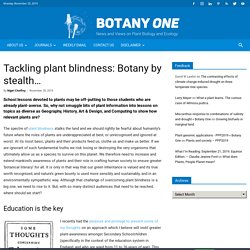
At its most basic, plants and their products feed us, clothe us and make us better. If we are ignorant of such fundamental truths we risk losing or destroying the very organisms that ultimately allow us as a species to survive on this planet. We therefore need to increase and extend mankind’s awareness of plants and their role in crafting human society to ensure greater ‘botanical literacy’ for all. It is only in that way that our green inheritance is valued and its true worth recognised, and nature’s green bounty is used more sensibly and sustainably, and in an environmentally sympathetic way. Although that challenge of overcoming plant blindness is a big one, we need to rise to it. Education is the key. An Artist Develops a Daily Habit of Drawing Plants During COVID-19. Art in lockdown: Making anthotype plant prints. To help maintain his wellbeing during the coronavirus lockdown, photographer Tim Boddy turned to a natural process to create beautiful prints of flowers and leaves, known as anthotypes. image copyrightTim Boddy When Tim Boddy couldn't leave his home more than once a day for exercise, because of lockdown restrictions, he used the time to gather local flowers and leaves in and around Bow in East London.
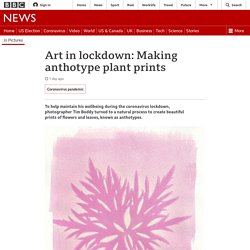
He then used a photographic technique that dates back to the mid-1800s to create colourful silhouettes of plant material, using natural chemicals from the plants and the power of the sun. Boddy created 147 anthotype plant prints during lockdown. Museum Plantin-Moretus. @SLCUPlants Task 7: Make a herbarium specimen #Planttaskmaster and @CUHerb Cosmos Bipinnatus from my garden. Quarantine Herbarium on Instagram: “□□□□□□□ □□□□□□□□□□□. (Common Fumitory.) Cyanotype print by @williamlawrencearnold ⠀⠀⠀⠀⠀⠀⠀⠀⠀⠀⠀⠀⠀⠀⠀⠀⠀⠀⠀⠀⠀⠀⠀⠀⠀⠀⠀⠀⠀⠀⠀⠀⠀⠀⠀⠀ ‘Quarantine…” The Center for Education of The College of Physicians of Philadelphia. Quarantine Herbarium. □□□New specimens for the #QuarantineHerbarium from one of my fav NYC-based writers, @AllisonCMeier, who has written about everything from plants to ghosts + photography. Check out her work.
@eayers0 a teaching version of #QuarantineHerbarium. @eayers0 @dimitriforero Today is the day! 1. Collect your specimens 2. Record important information about them 3. Press 4. Wait! (a couple of days to a couple of weeks) Sambucus nigra, Solanum tuberosum and Ruta graveolens were the first plants I collecte. Quarantine Herbarium: citizen art-science - Eden Project, Cornwall. What is Quarantine Herbarium?
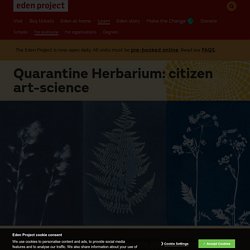
Conceived during the early days of lockdown, Quarantine Herbarium has been set up to help people observe local flora in detail while enjoying the satisfying process of making a beautiful print at home using a free kit. The idea is that this participatory botanical photography project helps build up an online and physical collection of specimens from around the UK, forming an important record of an unusual interaction with an oft overlooked part of the natural world. See the results so far on the Quarantine Herbarium Instagram feed. Through the process, whereby participants are encouraged to identify the plants they’re capturing, it’s hoped that it will go some way towards alleviating ‘plant blindness’* – where we struggle to recognise diverse flora. One of the artists behind the project, William Arnold, exhibited his own cameraless photographs as part of our Radical Botany exhibition. □□□Stunning new specimens up on the #QuarantineHerbarium today from @awkwardbotany! The QH has been slowing down with the start of the school year, but keep your eyes peeled for an exciting new site for it soon. I'll miss the daily beauty in my inbox!□□□
□□□Stunning new specimens in the #QuarantineHerbarium from @Raelynn_O in Beaver Co., PA. I'm in love with how Raelynn has mounted these flora on small (beautifully designed) maps, connecting them to their place. □□□Specimens QH090-QH095 in the #QuarantineHerbarium came in today: including cherry blossoms + rapeseed from Roberta Caldas Schmoi (Berlin) and bleeding hearts from @HPealeEwing (Greenwich). How are your pressings going?□□□ □□□A red letter day for the #QuarantineHerbarium! New specimens from old contributors Nanik Adnani (Toronto) + Lou Cabeen (Seattle), plus a whole bevy of Texas wildflowers from beloved @LydiaPyne. QH INSTRUCTIONS. Are you stuck inside + miss nature? Contribute to the #QuarantineHerbarium, a collection of plant specimens collected on your socially isolated walks + from your #victorygarden. Find instructions here/DM me with questions. #botany #plants #nature #sciart.
Remote Research: Herbarium at Home – Discover + Share. Throughout the world, closures and lockdowns aimed to stop the spread of COVID-19 have disrupted many people’s lives and work.

As a global institution, the Missouri Botanical Garden does research around the world, making travel restrictions a major hindrance. The “stay at home” order means staff has lost access to the Garden’s herbarium and labs, too.But of course, they’ve adapted. Some are using the time to catch up on data analysis. Others are completing manuscripts, which communicate the findings of their work, and floras, a descriptive list of plants in a particular region.
And in more remote locations, like protected sites in Madagascar, conservation efforts go on. Critical conservation work isn’t achieved just by venturing into wild, remote areas to locate rarely-seen species. With 7.5 million specimens, the Missouri Botanical Garden’s herbarium is among the largest in the world. “I was very excited,” Plant Mounter Team Lead Sally Bommarito says. @StreetBotany (@streetbotany) / Twitter. Ep. 262 - On the Origin & History of Field Guides. This week we take an even closer look at the world of field guides with science historian Dr.

Sara Scharf. Field guides began as a tool for botanists to better understand the plants in their region but they have since grown to encompass all forms of life. An Online Art Lesson from Pantea Karimi – Marsh's Library. Press Flowers for a 'Quarantine Herbarium' #StitchTogether: Communal Embroidery Project.
At the McClung Museum, we’re holding onto summer with this embroidery pattern based on Ixia Dubia, Plate 64 from Les Liliacees, Vol.

II, a print by Pierre-Joseph Redoute from the McClung Museum’s Nature Print Collection. The yellows, orange, and dashes of pink embody the freshness and joy of Redoute’s print. Want to create your own? Take a look at the instructions below or download them in the pdf pattern. Each month we will share an embroidery pattern based on our collections.
Download our first #StitchTogether tutorial sheet! Inserted between the book leaves are slips of paper—like forgotten pressed leaves and flowers one finds in old books. Following the metadata format of an herbarium (h/t @eayers0), the paper slips document the plant name and where and when it was found. Preserve Your Quarantine Nature Walks with a DIY Herbarium. Even in the era of COVID-19, Elaine Ayers is usually at the park by 7:00 a.m. When her goldendoodle, Franklin, has gotta go, he’s gotta go—“He’s still a baby even though he’s like a hundred pounds,” she says—and they head out for short walks several times a day in the Philadelphia neighborhood of Fishtown. She doesn’t see many people at the moment, but as they head home, she marvels at their leafy neighbors.
Ayers, who teaches in the museum studies department at New York University, studies 18th- and 19th-century botanical specimens, but lately she has become especially attuned to their more contemporary counterparts—native plants thriving under an overpass, cherry blossoms painting the parks pink, weeds shoving up through the concrete. Today #MuseumWeek is inspired by @GettyMuseum's recreating an artwork at home #CultureinQuarantineMW. Be inspired by @The_RHS herbarium and recreate one of our specimens. Here's mine made from paper and stamps - and for guidance on pressing. And here are some more of @The_RHS herbarium's specimens to recreate for the #CultureInQuarantineMW challenge.
Here's a #DIY project for the holiday weekend, courtesy of our Botany Department: build a plant press! Wrangle some basic household supplies and start pressing. #NatureNerding101. Why a Herbarium of 7.8 Million Plants Is One of New York's Most Valuable Resources. After a corpse flower opened at the New York Botanical Garden (NYBG) last summer, drawing 30,000 visitors in the course of its brief and pungent bloom, it received the posthumous honor of becoming the three millionth specimen digitized from the Bronx institution’s herbarium. While NYBG is among New York City’s great green wonders, it’s also home to the world’s second-largest herbarium, created just after the garden was established in 1891.
The William and Lynda Steere Herbarium now houses 7.8 million plant and fungal specimens, representing biodiversity from every continent. 'Not just weeds': how rebel botanists are using graffiti to name forgotten flora. A rising international force of rebel botanists armed with chalk has taken up street graffiti to highlight the names and importance of the diverse but downtrodden flora growing in the cracks of paths and walls in towns and cities across Europe. The idea of naming wild plants wherever they go – which began in France – has gone viral, with people chalking and sharing their images on social media. More than 127,000 people have liked a photo of chalked-up tree names in a London suburb, while a video of botanist Boris Presseq of Toulouse Museum of Natural History chalking up names to highlight street flowers in the French city has had 7m views.
Presseq told the Guardian: “I wanted to raise awareness of the presence, knowledge and respect of these wild plants on sidewalks. People who had never taken the time to observe these plants now tell me their view has changed. Morethanweeds (@morethanweeds) / Twitter. The French city of Nantes offers residents seed packets to sow in pavement cracks, with non-natives & native species adapted to cities (wallflower, toadflax, poppy etc). It is hoped that this will help people accept "wilder" streets & spontaneous. A new journey with Manchester Museum – behind the scenes with Lindsey Loughtman. Natural History Museum. You will need: books newspaper card PVA glue pen What to do: 1. 2. A Lockdown Flora of Melville Street, Edinburgh: Chloris Via-Melvilliana.
Henry Noltie Introduction In 1823 Robert Brown published an account of the plants collected on Melville Island in the Canadian Arctic during the first voyage (1819–20) commanded by William Edward Parry in search of the elusive North-West Passage on the ship Hecla. (The plants were collected by Parry himself, the astronomer Edward Sabine, the surgeon John Edwards and his assistant Alexander Fisher, and James Ross; there are many duplicates in the RBGE herbarium). Brown, for the title of his account, instead of using the conventional Latin name of the goddess of flowers as a ‘Flora’, used her Greek equivalent Chloris, and called his work Chloris Melvilliana. Chloris Via-Melvilliana – addendum, June 2020. Ever wondered how a plant specimen gets turned into an herbarium sheet for a museum collection? Discover how you can do something similar at home, using plants from your garden with @Aristolochia LIVE on Persicope, Sunday at 2pm! Part of #MFoN @MancNature.
Oak Spring Garden Foundation - A rhododendron a day. Where have you been the past few months? Since early March, I have been at home east of Cleveland. I had just completed a work trip to New York City, and Ohio began to shut down days after my return. Historically, what ideas, issues, and subject matter(s) have inspired your work? Bordeaux stopped using pesticides on pavements a few years ago and this is what they look like these days... lots of □□□□□□□ and I ❤️ the messiness. Kids can discover the artistry of nature in a single leaf. Today, join NYBG's Arvolyn Hill—Coordinator of Family Programs for our Everett Children's Adventure Garden—to learn about leaf rubbings and the meanings of the colors in the Pan-African Flag.
Task 5: Leaf shapes — Sainsbury Laboratory. Monday 29th June - Sunday 5th July 2020. Everyone can take part in #PlantTaskMaster with @slcuplants and @CUHerb @plantsci - you have a month to get pressing, folks! Happy Herborising!□□□□□□□ #IamABotanist #LovePlants #Herbarium @CambPlants @CamUnivMuseums @yourscambridge @BioSciImpact. Fantastic Flora.